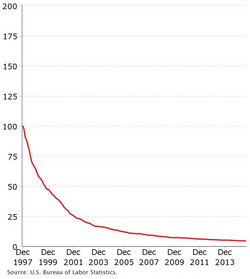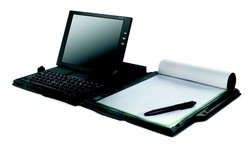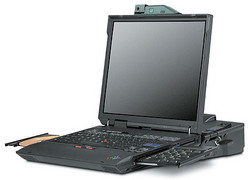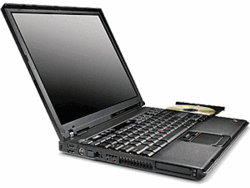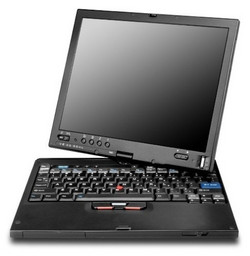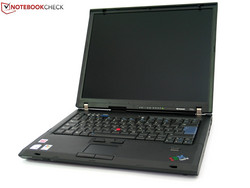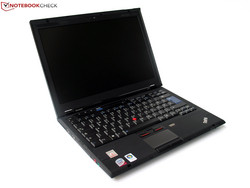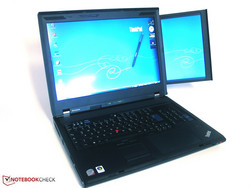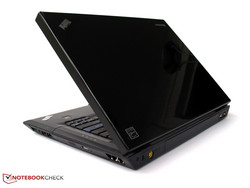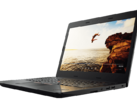25th ThinkPad Anniversary, Part 2: The Crises of the 2000s and the Transition to Lenovo
For the original German article, see here.
The second installment of our three-part ThinkPad story covers the turn of the millennium (see here for the first part).
IBM successfully entered the notebook market in the 90s and managed to establish its ThinkPad brand as an innovative and premium series of laptops. The market kept growing seemingly endlessly, and notebooks matured enormously with every new generation. One indicator for this was the display sizes: in the early 2000s the most common sizes were 13, 14, and 15-inches; dimensions that have remained largely identical until today.
Thanks to larger displays, built-in CD and DVD drives, and more powerful processors, the laptop market reinvented and transformed itself. The multimedia segment was born and the focus shifted from business to consumer: notebooks became a staple.
The Price War and IBM's crisis
IBM suffered greatly from this development. While differentiation in the early 90s happened mainly through features and quality, a fierce price war ensued in the late 90s. The notebook market kept growing and growing with new competitors from Asia entering the market, and production capacities were shifted eastwards. Consequently, prices were in free-fall. In addition, the Dot-com bubble burst in 2000 effectively bringing the boom of the 90s to a screeching halt. Understandably, consumers’ willingness to pay high prices for notebooks fell to an all-time low.
ThinkPads have always been IBM’s top-of-the-line series of notebooks, both in terms of price and technology. Yet suddenly, IBM was losing money left and right and had to lower its prices drastically in order to remain competitive. It should come as no surprise that this also meant sacrificing their once high quality standards, and even that wasn’t enough to remain profitable enough. IBM’s computer division was hit hard by this development, and it turned out to be a major disaster: the company was unable to lower prices fast enough without sacrificing too much quality, rendering the PC business unprofitable in no time. Slowly but surely IBM was retreating from computer sales, and the writing was already on the wall: computer sales were no longer part of IBM’s core business.
The final IBM ThinkPads of the early 2000s
But IBM wasn't quite done just yet and continued producing and selling ThinkPads well into the early 2000s for another five years. Let’s take a closer look at some of the more interesting (in a good and bad way) models of the early 2000s.
Before we talk about specific models, it would make sense to introduce you to IBM’s naming conventions, which had undergone a significant update in early 2000. Back in the 90s, ThinkPads were simply consecutively numbered: 300, 500, 600, 700, etc. In 2000, IBM introduced the so-called XTRA generation (the four letters with which all future ThinkPad names should start) of notebooks to render naming more transparent. The positioning of these four was as follows:
- ThinkPad X-series: ultra-portable and small sub-notebooks. The X stands for “extra light and small”.
- ThinkPad T-series: high-quality all-rounders, bigger than the X but smaller than the A-series. T stands for “thin and light" and is the successor to the ThinkPad 600 series.
- ThinkPad R-series: affordable budget notebooks - the R stands for “reliable”.
- ThinkPad A-series: the most powerful and versatile ThinkPad series and successor to the ThinkPad 700 series. Portable workstations, the A stands for “desktop alternative”.
IBM ThinkPad TransNote
The ThinkPad TransNote is without a doubt the quaintest model of the late IBM ThinkPad years. Rather than a traditional notebook it’s a combination of notebook and, well, notebook. The paper version, that is. Opening the TransNote reveals the keyboard and display on the left-hand side, and there is a paper scribbling pad on the right. This scribbling pad was placed on top of a digital input device recording everything that was written and transferring it onto the PC instantly if required.
While this innovative concept was ahead of its time back then it never found its niche and failed in the marketplace. Consequently, it was discontinued fairly quickly.
IBM ThinkPad A30p
The ThinkPad A-series was a rather short-lived line of notebooks. The A30(p) was the second-to-last and the updated A31p, introduced in 2002, was the final model of the A-series. IBM’s plans were to have the T- and R-series take over the workstation part of the A-series in future releases and the A-series became one of the victims of IBM’s cost-cutting measures in the early 2000s.
Both A-models turned out to be quite impressive, though. For one, they were equipped with two modular UltraBay drive bays. The UltraBay, a feature rendered obsolete with ODDs later on, supported several replaceable modules, such as additional batteries, hard-disk drives, optical drives, or in case of the A30p even an optional pull-out numeric keypad. The A31p was the last ThinkPad with two UltraBay slots, and to this day the A-series remains the most versatile and modular ThinkPad series ever made. In addition to its legendary versatility, the A30p’s display was just as noteworthy. It was the first ThinkPad sporting a UXGA (1600x1200) IPS display (referred to as FlexView by IBM). This might not seem worth mentioning today but back in the early 2000s low-resolution XGA (1024x768) TN panels were the most common display option available.
The fact that the A-series was discontinued so soon despite its futuristic versatility and progressiveness can be taken as a prime example for the struggles of trying to make money with innovative and expensive PCs in the notebook market of the early 2000s.
IBM ThinkPad T40
The T40 series introduced in March 2003 was the final generation of T-series ThinkPads made by IBM. The T40 through T43 were very thin and the first ThinkPads equipped with Intel’s Pentium M CPUs.
The T40 is a byproduct of IBM’s dependence on Intel. In the early 2000s, the Pentium 4 was Intel’s most current microprocessor based on the brand-new Netburst architecture. It was designed for ever higher frequencies and, accordingly, ever hotter CPU cores. The Prescott generation was particularly notorious for its high power consumption and energy inefficiency. While desktop PCs managed to dissipate the resulting heat with ever larger coolers and loud fans, notebooks were an entirely different story: the Pentium 4 was simply not suitable for notebooks. Accordingly, the T40’s predecessor based around the Pentium 4 processor - the T30 series - was rather short-lived and quickly replaced by the Pentium M-based T40.
Being the first microprocessor not based on the ill-famed Netburst architecture, the Pentium M was a giant leap forward for Intel. Unfortunately, what we remember today from those days are the T40’s problems and flaws. For one, the flimsy and thin case resulted in death by flexing (soldered BGA chips separating from the motherboard). The flexing issue was so widespread that it even managed to overshadow the fact that the T42, the second update to the original T40, was the first notebook ever to feature a fingerprint-reader. This is a technology most commonly used in smartphones today.
IBM/Lenovo ThinkPad X41 Tablet
Technically speaking, the X41 Tablet was the first ever ThinkPad made by Lenovo. However, its release a few months after the takeover by Lenovo means that it was most certainly still developed by IBM prior to the closing of the deal.
As part of Microsoft’s Windows XP Tablet-PC initiative in June of 2005, the X41 Tablet is the first modern ThinkPad convertible. It was also the first ThinkPad convertible featuring the classic swivel-hinge design with a single hinge in the middle around which the display swivels and folds back on top of the keyboard. Unlike previous convertibles, the X41 turned out to be quite successful, and the design remained in use by Lenovo until 2012. The last X-series tablet was the ThinkPad X230 Tablet.
The following video showcases the X41 Tablet in action:
The End of an Era: IBM Sells its PC Business to Lenovo
2004 marked the end of IBM’s once proud and profitable PC business. In the years leading up to its demise, IBM lost more than a billion dollars trying to sell PCs and ThinkPads. Lenovo, a Chinese company, announced its intention to purchase IBM’s entire PC business in 2004 and the deal was finalized in May of 2005.
Little known side-fact: Notebookcheck came to life in the final months prior to the acquisition and some of our first reviews covered the last batch of IBM ThinkPads, among others the IBM ThinkPad T41p and the ThinkPad R50p (reviews only available in German).
Lenovo was facing an enormous task: on the one hand, the acquisition had to pay off and the PC business had to become profitable again as soon as possible. On the other hand, Lenovo had to fulfill the high user expectations IBM had successfully built and maintained. The fact that Lenovo was a Chinese company was more of a hindrance than a help. After all, Chinese-made products had a certain reputation, and these clashed blatantly with what the ThinkPad name stood for. What follows are the first few Lenovo-made ThinkPads.
Lenovo/IBM ThinkPad T60
Over time, the T-series became the brand’s main driving force and the T60, first introduced in 2006, was Lenovo’s first attempt to continue the IBM legacy. On the outside, it was almost impossible to tell that the T60 was not made by IBM but by Lenovo: together with the ThinkPad brand and the PC business, Lenovo had also acquired IBM’s entire Japan-based ThinkPad engineering and design division. Some minor design modifications aside, the T60 was very similar to the T40 and continued to sell under the IBM logo, which Lenovo had purchased the rights to for a couple of years.
But there’s more. Not only was the T60 Lenovo’s first foray into the ThinkPad T-series arena, it was also the first T-series ThinkPad featuring a dual-core processor, a 3G modem, and the now famous magnesium-alloy roll cage. The latter basically all but eliminated the T40’s flexing defect and made the base unit much more rigid and sturdy. Regarding the display, Lenovo decided against following the widescreen trend just yet and offered the T60 with either a 4:3 FlexView IPS panel (see our review of this particular model here) or an optional 16:10 widescreen panel.
Shortly thereafter, notebooks with 4:3 displays practically disappeared from the market, and widescreen displays came out on top. This was a development many users were very discontent with until now. After all, 16:10 or 16:9 widescreen displays offer less vertical screen real estate which can be disadvantageous for many applications and scenarios. Even today many websites are optimized for 4:3 displays.
Lenovo ThinkPad X300
Despite the largely smooth transition from IBM to Lenovo, some skeptics remained very vocal. This was a challenge the ThinkPad team responded to with the ThinkPad X300 in February 2008. This ThinkPad was deemed to be proof that Lenovo was indeed a worthy successor to IBM.
It was the first ever ThinkPad not bearing the IBM logo anymore. Lenovo intended to proceed with its own brand name two years earlier than initially expected in order to create and enhance its own brand-name recognition and reputation. For a short period of time, the IBM logo remained in use at least for some ThinkPads but now it was officially gone for good. Not only that, in addition to replacing the beloved IBM logo with its own branding, Lenovo also changed the naming conventions by keeping the letter and then adding an extra digit to the number following the letter. Since then, the first digit of the now three-digit number has represented the display size. So, in the case of the X300, the 3 represents a 13.3-inch display. This nomenclature has not been touched since and is still in use today.
Needless to say, the X300 was not only an important symbolic milestone but a technological one to boot. It was the lightest and thinnest 13.3-inch ThinkPad ever made, with a case made mostly of expensive carbon-fiber housing an incredibly thin DVD drive. It just so happened that the X300 was released at the same time as Apple’s original MacBook Air. Accordingly, it was seen as the better alternative by many, even though it was never intended as such.
Lenovo ThinkPad W700ds
The same year, Lenovo not only tried to conquer the thin-and-light premium notebook market but also took a leap forward into the portable-workstation segment. By introducing the new W-series Lenovo created a separate workstation line of ThinkPads. The 15-inch W-series models were built around the exact same case as the T-series, which means that the W500 and T500 were almost identical.
However, the 17-inch W700 and its successor, the W701, were the much more interesting portable workstations with a unique case they didn’t have to share with any other model. Accordingly, Lenovo was able to include a number of enhancements, such as a Wacom digitizer in the palm rests, a WUXGA (1920x1200) RGB LED display, or two ThinkLights to illuminate the large keyboard. Even more impressive and interesting were the W700ds/W701ds models with additional fold-out displays.
Lenovo ThinkPad SL500
Unlike previously discussed models from the Lenovo period, the SL500 is not a high-end ThinkPad. Quite the contrary, the SL-series was meant to be an affordable low-end line of ThinkPad notebooks positioned below the already existing entry-level ThinkPad R-series. While ThinkPads such as the X300 or W700ds proved that Lenovo was a worthy successor to IBM in the premium market of high-end notebooks, the SL500 showcased Lenovo’s intentions to expand the legendary ThinkPad name into the segment of affordable notebooks as well.
On the outside, the SL500 was a mix between a typical ThinkPad and a typical multimedia notebook. Still living and breathing the legendary ThinkPad design, the case was made of much cheaper material. For example, the display lid was made of glossy plastic, and the SL500 was also the first ThinkPad featuring the new six-row style keyboard. Unlike its business-oriented brethren the SL500 also featured a glossy display and an optional Blu-ray drive.
Its most often criticized downside was the new keyboard. Lenovo went too far in its attempt to cut costs, and the keyboard turned out very flimsy. Despite the SL500’s lack of success low-end ThinkPads were bound to stay.
Conclusion: Out of the Frying Pan into the Fire
All things considered, Lenovo did a great job taking over IBM’s PC business. The systems remained largely identical and the entire ThinkPad team was a major part of the transition from IBM to Lenovo. However, prices had to be lowered subsequently in order to remain profitable and these measures did come at a price (such as, for example, the flimsy and flexing keyboards). Among other things exotic options, such as the expensive 4:3 IPS panels, had to be dropped as well.
Yet Lenovo never managed to escape the firm grasp of business customers and remained dependent on them, and it went head-on into risky ventures such as the X300 or W700ds. This strategy would get back at them eventually in 2008 when the next global economic crisis hit and the PC business crashed over night. Lenovo got into the red once more and their CEO at the time had to step down. In the third and last installment of this series we will take a look at the years between 2010 and 2017, Lenovo’s crisis management, and the inevitable effects this crisis had on the ThinkPad brand.



